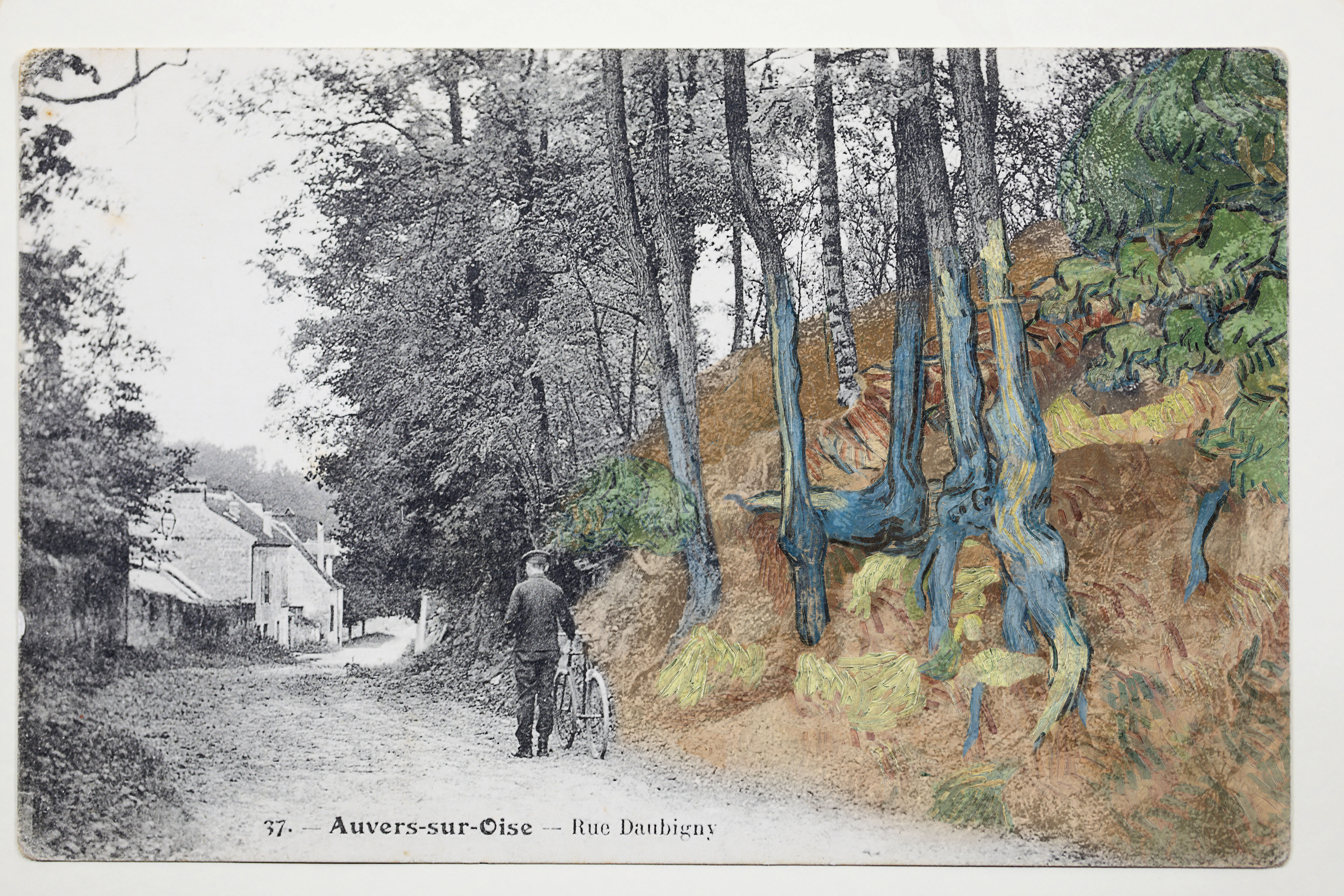
The great artist Vincent van Gogh was painting just hours before his fatal, likely self-inflicted shooting—and now it would appear that we know exactly where, thanks to the discovery of a historical postcard of a bicyclist on the Rue Daubigny in Auvers-sur-Oise, the town 20 miles north of Paris where Van Gogh spent his final days.
The breakthrough was made by Wouter van der Veen, the scientific director of the Institut van Gogh, a nonprofit in charge of preserving Van Gogh’s Auvers lodgings, in the Auberge Ravoux inn.
“Every element of this mysterious painting can be explained by observation of the postcard and the location: The shape of the hillside, the roots, their relation to each other, the composition of the earth and the presence of a steep limestone face,” he said in a statement issued by the Van Gogh Museum in Amsterdam, which has endorsed the finding.
A 94-year-old French woman had lent Van der Veen her collection historical postcards for his research, but the significance of the image, taken around 1905, didn’t initially register. Then, one day during lockdown, he realized that there was something familiar at about the gnarled tree roots and vegetation on the side of the path. Could this be what Van Gogh had been looking at the very last time he took paintbrush to canvas?
Diagram showing Vincent van Gogh’s possible position while painting Tree Roots (1890), as compared to the postcard Rue Daubigny, Auvers-sur-Oise. ©arthénon.
“The overgrowth on the postcard shows very clear similarities to the shape of the roots on Van Gogh’s painting,” said Teio Meedendorp, a senior researcher at the Van Gogh Museum, in a statement.
As France began reopening in May, Van der Veen traveled to Auvers to see if he could find the spot in the photo. He was pleased to discover that the path was just a stone’s throw—about 500 feet—from the Auberge Ravoux inn. The largest tree trunk in the painting and photograph was still there.
“The sunlight painted by Van Gogh indicates that the last brush strokes were painted towards the end of the afternoon, which provides more information about the course of this dramatic day,” said Van der Veen, who is publishing the theory in his new book Attacked at the Roots.
The trees today on the Rue Daubigny, Auvers-sur-Oise where Vincent van Gogh likely painted his last canvas. ©arthénon.
Today, Van Gogh Museum director Emilie Gordenker, and Willem van Gogh, the great-grandson of Van Gogh’s brother Theo, marked the 130th anniversary of Van Gogh’s death on on July 29, 1890, with a ceremony on the site in Auvers. They erected a plaque identifying the art historical significance of the otherwise unremarkable tree roots.
“That this is [Van Gogh’s] last artwork renders it all the more exceptional, and even dramatic,” said Meedendorp. “He must often have passed by the location when going to the fields stretching out behind the castle of Auvers, where he painted several times during the last week of his life and where he would take his own life.”
For years, art historians believed that the ominous-looking Wheatfield With Crows had been Van Gogh’s final work—John Berger claimed as much in his famed documentary Ways of Seeing, and the painting features prominently in the fatal climax of Vincente Minnelli’s 1956 biopic of the artist, Lust for Life.
Vincent van Gogh, Wheatfield with crows (July 1890). Courtesy of the Van Gogh Museum.
But Andries Bonger, brother-in-law to Theo van Gogh, wrote in an 1893 article that “the morning before [Vincent van Gogh’s] death he had painted a forest scene, full of sun and life.” In 2012, Van Gogh Museum senior researcher Louis van Tilburg and Bert Maes, dendrologist who specializes in historical vegetation, published a now widely accepted paper determining that Bonger was talking about Tree Roots.
Both men now believe the tangled root system that Van Gogh painted in dappled golden sunlight has been found.
Van der Veen believes the work offers important clues as to how Van Gogh spent his final hours. “The sunlight painted by Van Gogh indicates that the last brush strokes were painted towards the end of the afternoon, which provides more information about the course of this dramatic day ending in his suicide,” he said.
Vincent van Gogh, Tree Roots (1890). Courtesy of the Van Gogh Museum, Amsterdam, and the Vincent Van Gogh Foundation.
Theories continue to abound over how, exactly, Van Gogh died. The Van Gogh Museum and most experts maintain that it was a suicide, but in a 2011 biography, Van Gogh: The Life, Steven Naifeh and Gregory White Smith contend that the artist instead quarreled with two young boys who accidentally shot him.
Naifeh believes this new information about Tree Roots could support his theory. “It was otherwise a productive normal day, and that runs counterintuitive to the idea that he might then go and kill himself,” he told the New York Times. “The fact that he went out and painted all day, not just an average painting but a very important painting, indicates that he may not have been depressed.”